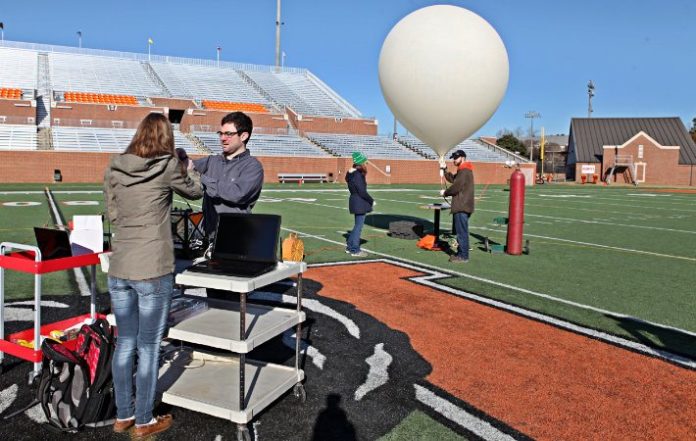MACON – Mercer University Associate Professor of Electrical and Computer Engineering Dr. Anthony Choi and 23 students are partnering with NASA to launch a high-altitude balloon from Sunset, South Carolina, on Aug. 21 to capture footage from near space of the first total solar eclipse in the continental U.S. in 38 years.
The video, which will be live-streamed on NASA's website, is the latest in a series of collaborations between Mercer's School of Engineering and NASA, building toward plans for an academic center focusing on high-altitude payload delivery on the Macon campus.
“We're trying to develop a very low-cost medium for people to gain access to near space for experimentation and data collection,” said Dr. Choi, who also oversees Mercer's Machine Intelligence and Robotics Laboratory.
NASA currently offers the opportunity for universities, high schools and nonprofit organizations to design and provide experiments to be included in 10-cubic-centimenter CubeSats for launch into outer space. But this process is highly selective and expensive, as it costs around $10,000 per pound for payload to be delivered into earth's orbit.
NASA recently set a goal to reduce the cost of such experimentation into the hundreds of dollars per pound over the next 25 years. Dr. Choi's proposed, first-of-its-kind center could provide access to near space – between 65,000 and 328,000 feet above sea level – well within that goal at around $500 per payload.
Each of the center's missions would involve two 6-pound payloads each containing up to eight experiments for a total of up to 16 experiments per launch. Experiments might investigate factors such as pressure, temperature, wind speed, the presence of pollutants or radiation, the fragility of glass, or the passage of time as measured by mechanical clocks at different levels of the atmosphere. A typical mission would last anywhere from three to five hours from launch to recovery.
The opportunity for recovery is a key advantage of sending these experiments into near space. While NASA's CubeSats only provide data since they do not return intact from space, Dr. Choi and his students can have a team en route at launch for the location where a balloon is expected to land.
“Our vision is that, more and more, students would look at space as something they can easily gain access to, experiment with, touch and feel,” said Dr. Choi.
NASA began providing grants to Dr. Choi in 2010 with a two-pronged goal of outreach – especially to K-12 students – as well as the capability to conduct research and build systems toward NASA's goals.
This work originated with a project by Engineering Honors Program students James McNichols and Spencer Penley, who as freshmen began investigating mechanisms for delivering experiments into space. Under the advisement of Dr. Choi and with funding from NASA, these two students carried this project into their senior year and won several awards, including one from the American Society for Engineering Education.
Dr. Choi envisioned taking this student work to “the next level” by developing a Center for High-Altitude Payload Delivery, which attracted the attention of the Georgia Space Grant Consortium. Through contact with the consortium, Mercer was selected to represent the state through NASA's efforts to promote and document this year's total solar eclipse.
Dr. Choi, McNichols and Penley traveled to Montana State University last July for a weeklong intensive workshop on high-altitude ballooning. They've spent the past year leading nearly two-dozen engineering undergraduates through a similarly intensive program focusing on various components of the balloon launch system.
McNichols and Penley, who graduated in May, have passed on leadership responsibilities to current students such as Kyle Struck, Andrew Robinson, Jacob Sokolove and Timothy Hood. A tethered launch is planned to test the system in the days leading up to the eclipse.
Dr. Choi and his students have also been involved in other NASA-funded outreach projects, including robotics training for Middle Georgia schools. Faculty and students provided extensive mentoring to RoboBibb, the Bibb County School District's first-ever robotics team. RoboBibb qualified for the For Inspiration and Recognition of Science and Technology (FIRST) Robotics Championship in its inaugural season in 2014 and won the state competition, advancing again to worlds, this past season.
Mercer's School of Engineering also partnered with the Putnam County Charter School System to train high school students to become FAA-certified drone pilots. Dr. Choi and Advanced Airspace Management co-founder John Granich developed a two-semester program that can accommodate 15 students at a time. The school system devoted more than $50,000 in manpower and resources to build a small airport for unmanned aircraft with a balloon landing site. This past March, Dr. Choi brought two subject matter experts from Kennedy Space Center to Putnam County to provide workshops on unmanned systems prior to his students launching a high-altitude balloon from the airport.
With information gained from these activities toward the development of a system to support primary and secondary schools and other universities through the planned center, Dr. Choi intends to spend the next academic year on a “finding mission” focused on how exactly the system will work and what additional resources are needed.
“We're in this to create opportunities for K-12 and other researchers,” he said. “We can become a hub for this type of research activity. Other universities have already shown interest in duplicating our model.”
About the School of Engineering
Mercer University's School of Engineering, founded in 1985, offers innovative and academically challenging programs that provide students with a comprehensive education, featuring a solid foundation in mathematics and sciences, a core engineering curriculum, a range of courses in engineering specialties and a strong emphasis on communication technologies. The School is consistently ranked by U.S. News and World Report as one of the top three master's-degree-level engineering schools in the Southeast. Known for its breadth of instruction in its undergraduate program and its five-year joint bachelor's and master's degree program, the School combines technical education with hands-on laboratory experience. Mercer engineers can look forward to joining fellow alumni in companies such as Warner Robins Air Logistics Complex, Lockheed Martin, Georgia Power, Siemens and Gulfstream Aerospace.










